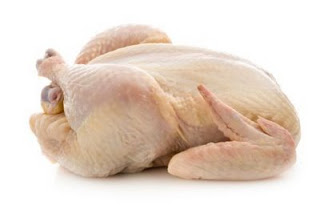Whoa!
Meat + Unsafe and Unsanitary = Your breakfast, lunch or dinner
I don't like the sound of that and I am thinking neither do you.
Many of the issues revolve around excrement (poop = Ewwww!) and other unwanted substances in meat, particularly beef and chicken. That is just some nastiness.
 |
| Feeding cows. Photo Credit: Articlesweb.org |
An older article from the LA Times detailed the practice of feeding chicken litter to cattle raised for beef production and the opposition to the practice from consumer groups. The FDA estimates that between 1 million and 2 million tons of poultry litter are fed to cattle annually. The thing about feeding chicken litter to cows is that there is a high risk of the cows becoming infected with bovine spongiform encephalopathy..........BSE for short...............aka Mad Cow Disease. The litter contains "high risk tissue" meaning animal tissues that may have the protein that is responsible for the infection. I was really wondering why the cows were being fed the excrement of other animals. I for one would not be that excited to find that on my dinner table. I kinda think the animals feel the same way. I mean what happened to some nice green grass. Can a cow get some nice green grass to eat? Dag! The answer came from Dean Cliver, professor emeritus of food safety at UC Davis in the last sentence of the article.
"Feeding animals may sound gross but it goes back to the dawn of animal agriculture...In the old days when people had mixed farms, what came out of the back end of the cows was eaten by the pigs, and what came out of the end of pigs was eaten by chickens. That was the natural way of farming. Anything hit the ground was fair game."
So it seems like business as usual. I'd advocate shutting down that business.
The subheading of the article reads, "Food and consumer groups say that the practices increase the risk of cattle becoming infected with mad cow disease. A beef industry trade group says a ban isn't needed". This seems to be an accurate representation of the conflict between public health interests and monetary interests. Industry consistently seems to be more concerned with profit than people.
 |
| Photo Credit: Nature-Education |
Since we're are on the topic of excrement, let's switch over to a different kind of meat. In a HuffPost article, Kathy Freston talks about the amount of fecal bacteria in the chicken that is purchased in the supermarket. The Center for Disease Control is pretty candid about the precautions one must take when handling raw meat. Ya know, cook your meat thoroughly, clean all surfaces and kitchen tools after contact with meat, use some kind of disinfectant, bleach, etc...........basically don't play around with Salmonella or E.coli. She uses a term that doesn't bring the best image to mind. It's called fecal soup.
Fecal soup forms during the industrial process where the intestines of the chickens are pulled out by a machine, contents go flying everywhere and a chilling bath gets filled with excrement covered chickens. This is fecal soup. One thing about chicken meat is that it is very absorbent. You will see why this makes a difference for chicken companies. From the article, the use of this technique seems to have one purpose only. To maximize profits. In a video, Dr. Neal Barnard provides a clear explanation of why the technique is utilized in chicken production.
"The slaughterhouses, they don't want to stop this. Why? Because chicken is sold by weight. And the fecal soup that soaks into the chicken muscle is sold just like the chicken product itself. It's a little bit heavier. If they had to remove all of that fecal soup, they wouldn't make as much money and they don't want you to know about it".
I like what he says next, "But doctors like me do want you to know".
The last kind of nastiness you have probably heard of already. Remember the arsenic in apple juice that Dr. Oz spilled the beans about and caused the news channels to go awry with headlines? Well, that was true but now arsenic has also been found in the chicken. The thing is that arsenic occurs naturally in foods but these levels found in the chickens were past the standard mark. An article earlier this year revealed the findings of a pair of studies done by the Johns Hopkins Center for a Livable Future.
The scientists discovered that arsenic in addition to antibiotics and drugs such as Tylenol and Benadryl were being fed to chickens. The agriculture industry doesn't readily disclose the details of their practices in terms of what exactly is being added to the chicken feed. Thus, the scientists cleverly assessed this by analyzing feathers of the chickens. "Bird feathers, like human fingernails, accumulate chemicals and drugs that an animal is exposed to." The article is quite witty and informative. Please do check it out!
Conclusion: Just know what you are eating my people. This information raises a lot of questions about what is really happening in the meat industry. It is true that you can't believe everything you hear, so you gotta do the research. Get informed and stay informed, aiight.
Check out the sources:
Chicken feces used for cattle feed
Poop in the chicken
Arsenic in the chicken
Thank you for reading. My people, I appreciate you all so much. Be healthy and happy. Ciao!

No comments:
Post a Comment